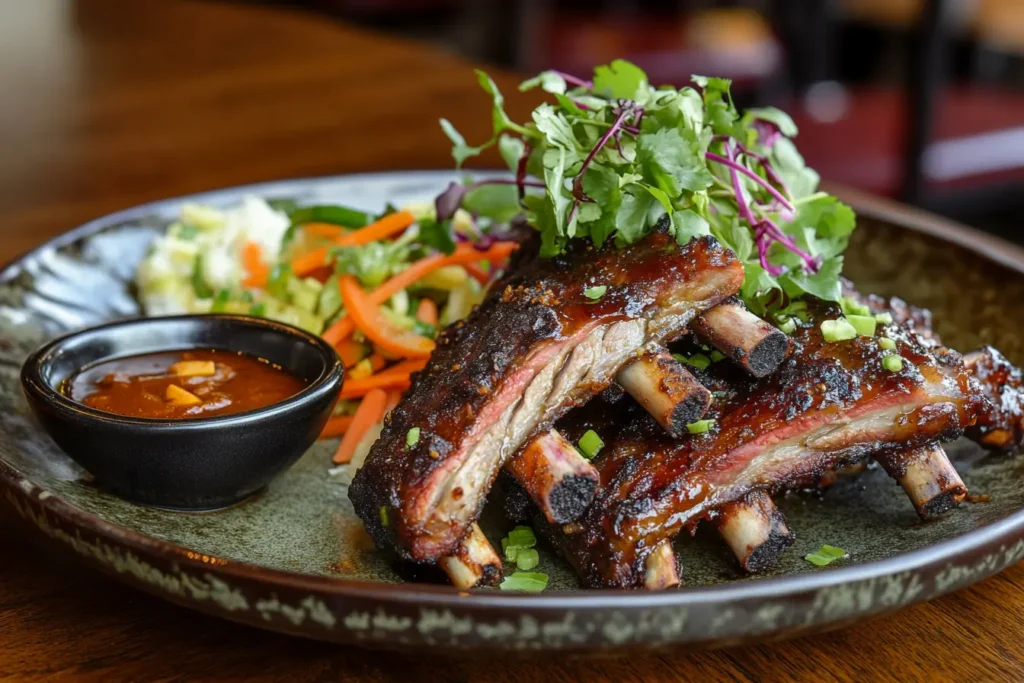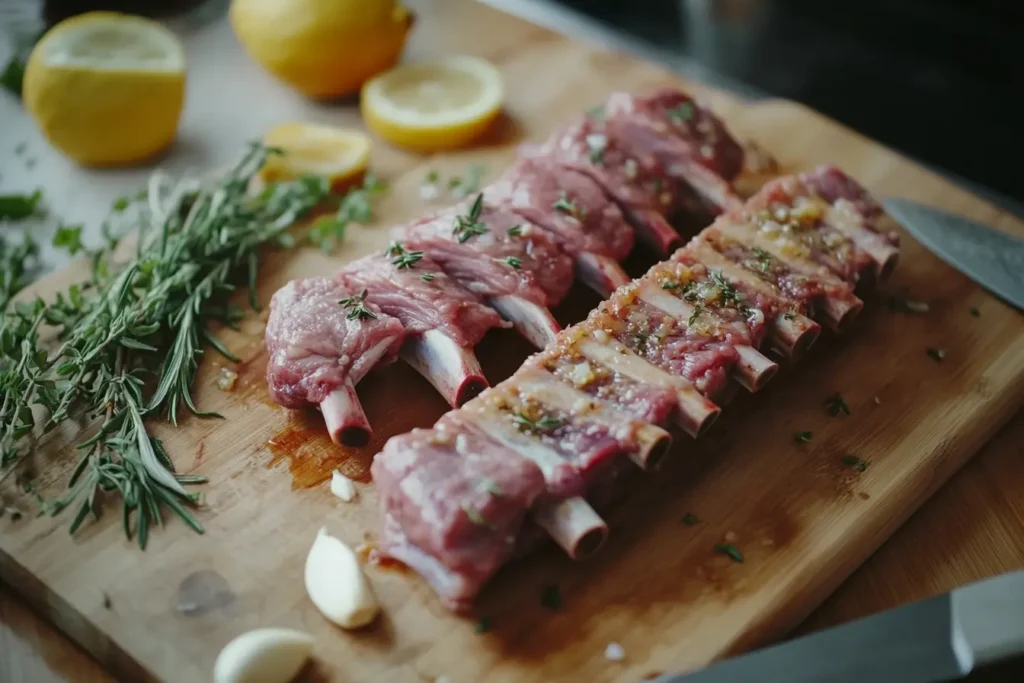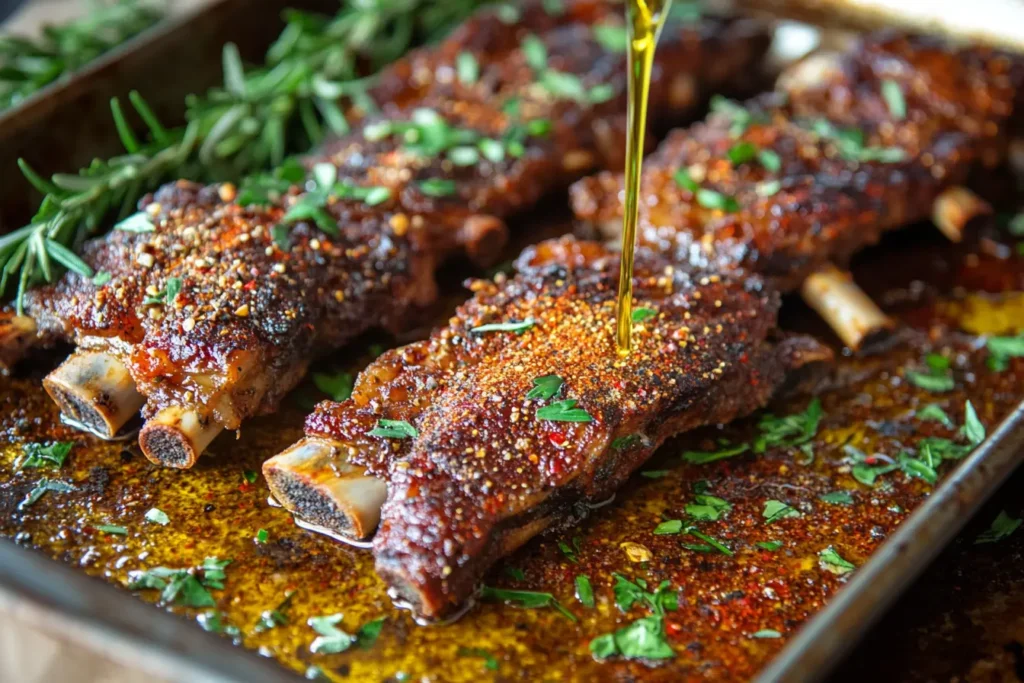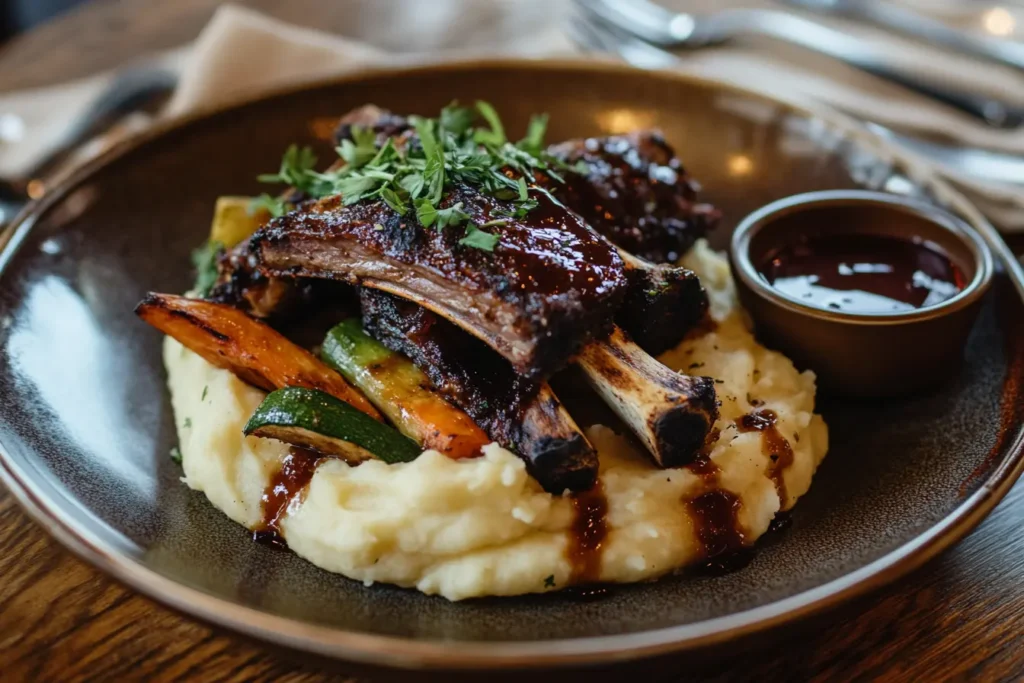Are you ready to master the perfect lamb ribs recipe? This comprehensive guide will walk you through every step, from choosing the best cuts to crafting irresistible flavors. Whether you prefer your ribs tender and juicy or with a golden, crispy crust, this lamb ribs recipe has something for everyone. We’ll cover essential techniques, seasoning tips, and cooking methods to ensure your dish stands out. So, roll up your sleeves and get ready to create a lamb ribs recipe that’s sure to impress your family and friends.

Introduction to Lamb Ribs
What Are Lamb Ribs?
Lamb ribs are a flavorful cut of meat that’s often overlooked but incredibly versatile. They’re located on the lower ribcage of the lamb, known for their rich, gamey taste and tender texture when cooked properly. Unlike the rack of lamb, lamb ribs are thinner with more fat, making them perfect for roasting, grilling, or slow cooking. Whether you’re new to cooking lamb or a seasoned chef, mastering a lamb ribs recipe opens up endless culinary possibilities.
These ribs are particularly prized for their marbling, which renders during cooking to create juicy, melt-in-your-mouth bites. Incorporating the right techniques ensures you unlock the full potential of this unique cut, making it a centerpiece at any meal.
Why Choose Lamb Ribs?
If you’re looking for a cut of meat that offers bold flavor without breaking the bank, lamb ribs are an excellent choice. They’re more affordable than premium lamb cuts like the rack, but they still pack a punch when it comes to taste. A good lamb ribs recipe will highlight their robust flavor while balancing the richness with complementary seasonings and marinades.
Another advantage is the versatility of lamb ribs. Whether you’re planning a casual barbecue, an elegant dinner, or experimenting with global cuisines, this cut adapts beautifully to various cooking methods and flavors. From smoky and spicy to tangy and herbaceous, there’s no limit to how you can customize your lamb ribs recipe to suit your taste.
Overview of Cooking Techniques
Preparing lamb ribs requires just a few basic techniques, but the results are worth the effort. Two popular approaches include the low and slow method, which makes the ribs tender and juicy, and the quick and hot method, which delivers a crisp, caramelized exterior. No matter which method you choose, the right balance of temperature, timing, and seasoning is key to a successful lamb ribs recipe.
From oven roasting to grilling or smoking, lamb ribs can be cooked in several ways, each offering unique flavors and textures. In the sections ahead, we’ll explore these techniques and provide detailed guidance so you can create lamb ribs that are as impressive as they are delicious.
Preparing the Perfect Lamb Ribs

Selecting High-Quality Lamb Ribs
A great lamb ribs recipe starts with the right ingredients, and the quality of the ribs is key. When shopping for lamb ribs, choose cuts that are fresh and vibrant in color. The ribs should have a pinkish-red hue with a slight marbling of fat, which ensures tenderness and flavor. Avoid ribs that appear grayish or have an unpleasant odor.
Knowing your cuts is also important. Spare ribs are larger and meatier, ideal for slow cooking, while riblets are smaller and thinner, perfect for quicker cooking methods. Whether you’re roasting, grilling, or smoking, selecting high-quality ribs sets the stage for a delicious dish.
Essential Tools and Equipment
Cooking lamb ribs to perfection requires a few basic tools. Start with a sharp chef’s knife to trim excess fat and prepare the ribs. A sturdy roasting pan or grill is essential for cooking, while a meat thermometer helps ensure your ribs are cooked to the perfect temperature. If you’re smoking the ribs, prepare wood chips for that signature smoky flavor.
Additionally, a sealable plastic bag or shallow dish works well for marinating. And don’t forget foil for wrapping the ribs during the slow-cooking process—it traps moisture, resulting in juicy, tender meat.
Prepping the Ribs: Cleaning, Trimming, and Marinating
Preparation is a crucial step in any *lamb ribs recipe. * Start by rinsing the ribs under cold water and patting them dry with paper towels. Trim away excess fat, but leave a thin layer for flavor. Removing the membrane on the back of the ribs is optional but recommended for better seasoning penetration.
Once cleaned and trimmed, it’s time to marinate. A marinade rich in citrus, garlic, and spices enhances the flavor of lamb ribs beautifully. Let the ribs sit in the marinade for at least two hours or, even better, overnight in the fridge. This step ensures every bite is bursting with flavor.
Cooking Techniques for Lamb Ribs
Low and Slow Method: Perfecting Tenderness
The low and slow method is a classic approach to making tender lamb ribs. Begin by preheating your oven to 300°F (150°C). Wrap the ribs tightly in foil to seal in moisture and place them on a baking sheet. Cook for 3-4 hours, depending on the size of the ribs. This slow process allows the fat to render, creating juicy, fall-off-the-bone meat.
After slow cooking, increase the oven temperature to 400°F (200°C), unwrap the ribs, and roast them for 20-30 minutes. This final step caramelizes the surface, giving the ribs a beautiful golden crust. If you prefer tender, flavorful ribs, this technique is foolproof.
Quick and Hot Method: Achieving a Crispy Crust
Pressed for time? The quick and hot method is your best bet. Preheat your oven or grill to 450°F (230°C). Coat the ribs with a flavorful spice rub or marinade, ensuring every inch is covered. Place the ribs directly on the grill or in a roasting pan.
Cook the ribs for about 20-25 minutes per side, flipping them halfway through for even browning. This method locks in flavor while delivering a crispy, caramelized exterior. While the ribs won’t be as tender as the low and slow method, the speed and simplicity make this technique perfect for busy days.
Choosing the Right Temperature and Timing
Temperature and timing are crucial to the success of any lamb ribs recipe. Thicker ribs require longer cooking times, while thinner cuts cook faster. Always use a meat thermometer to check for doneness. Lamb ribs are best when cooked to an internal temperature of 145°F (63°C) for medium-rare or up to 160°F (71°C) for well-done.
Let the ribs rest for 10 minutes after cooking. This allows the juices to redistribute, ensuring every bite is succulent and flavorful.
Oven-Baked, Grilled, or Smoked: Which is Best?
Each cooking method brings something unique to the table. Oven-baked ribs are easy and reliable, providing consistent results. Grilling adds a smoky, charred flavor, perfect for outdoor cooking. If you have the time and equipment, smoking infuses the ribs with deep, aromatic flavors.
Experiment with these methods to discover what suits your taste best. Whichever technique you choose, basting the ribs during cooking keeps them moist and enhances their flavor, making your lamb ribs recipe unforgettable.
Flavoring Lamb Ribs

Classic Spices and Herbs for Lamb Ribs
The right combination of spices and herbs can elevate any lamb ribs recipe to a gourmet experience. Traditional seasonings like garlic, rosemary, thyme, and paprika are timeless favorites that pair wonderfully with the rich, gamey flavor of lamb. For a bold kick, add a dash of cayenne pepper or smoked chili powder. Balancing savory spices with a hint of citrus zest or lemon juice enhances the ribs’ natural flavor.
When applying your spice mix, rub it generously into the meat to ensure even seasoning. Let the spices sit for at least 30 minutes before cooking, allowing the flavors to infuse deeply into the ribs.
Regional Flavor Variations
Lamb ribs take on a whole new character depending on regional seasonings. For a Mediterranean twist, use oregano, mint, and a drizzle of olive oil. Middle Eastern flavors, with cumin, coriander, and sumac, create a tangy, aromatic profile. Asian-inspired ribs often incorporate soy sauce, ginger, and sesame oil for a sweet and savory balance.
Experimenting with regional flavors not only adds variety but also ensures you never tire of making lamb ribs. Incorporate these ideas into your lamb ribs recipe to keep your culinary adventures exciting.
How Marinades and Sauces Enhance Flavor
Marinades and sauces are the secret weapons for flavorful lamb ribs. A marinade based on yogurt, lemon, and garlic tenderizes the meat while adding a tangy punch. For a smoky barbecue style, mix tomato paste, honey, and Worcestershire sauce for a sticky, caramelized finish.
Sauces can be served alongside or brushed onto the ribs during cooking. For example, chimichurri sauce, made with fresh parsley and vinegar, pairs beautifully with grilled lamb ribs. Incorporating marinades and sauces ensures your lamb ribs recipe stands out with bold, vibrant flavors.
Step-by-Step Lamb Ribs Recipe
Ingredients and Measurements
Every great dish begins with a detailed ingredient list. For this lamb ribs recipe, you’ll need:
- 3 pounds of lamb ribs (preferably spare ribs)
- 2 tablespoons of olive oil
- 1 teaspoon of garlic powder
- 1 teaspoon of paprika
- 1 teaspoon of dried rosemary
- Juice of one lemon
- Salt and pepper to taste
Optional: A smoky barbecue sauce or herb-based chimichurri for serving.
Detailed Instructions for Cooking
- Prepare the Ribs: Rinse the lamb ribs under cold water and pat dry. Remove the membrane from the back of the ribs if desired, and trim any excess fat.
- Season the Ribs: In a small bowl, combine garlic powder, paprika, rosemary, salt, and pepper. Rub this mixture evenly over the ribs, ensuring all sides are coated.
- Marinate: Drizzle olive oil and lemon juice over the ribs. Cover and let marinate in the fridge for at least 2 hours or overnight for maximum flavor.
- Cook the Ribs:
- Low and Slow Method: Preheat the oven to 300°F (150°C). Wrap the ribs tightly in foil and bake for 3-4 hours. Finish by roasting uncovered at 400°F (200°C) for 20-30 minutes.
- Quick and Hot Method: Preheat the grill to 450°F (230°C). Grill the ribs for 20-25 minutes per side, basting with sauce if desired.
- Rest and Serve: Once cooked, let the ribs rest for 10 minutes. Slice them into portions and serve with your favorite side dishes.
Pro Tips for Perfect Results
- Always let the ribs rest after cooking to retain their juices.
- For extra flavor, baste the ribs with marinade or sauce during the last 10 minutes of cooking.
- If you enjoy a smoky flavor, add wood chips to your grill or smoker.
For more delicious lamb dishes, check out this Lamb Breast Recipe for another savory treat!
Serving Lamb Ribs

Side Dishes to Pair with Lamb Ribs
A perfectly cooked lamb ribs recipe deserves equally delicious sides. Pairing the ribs with complementary dishes enhances the dining experience and brings balance to the meal. Creamy mashed potatoes or buttery roasted vegetables are classic choices, offering a comforting contrast to the rich flavor of the ribs.
For a lighter option, consider a refreshing side salad with crisp greens, cucumbers, and a lemon vinaigrette. Rice pilaf, couscous, or quinoa also pair well, adding texture and substance to the meal. For a Mediterranean touch, serve the ribs with tzatziki sauce and warm pita bread.
Presentation and Garnishing Ideas
Presentation is everything when it comes to serving lamb ribs. Arrange the ribs on a large platter, stacking them neatly for an appealing display. Sprinkle freshly chopped parsley or rosemary over the top for a pop of color and added aroma.
A drizzle of your favorite sauce or a side of dipping options like chimichurri or barbecue sauce elevates the dish. Don’t forget to serve the ribs with lemon wedges for a final citrusy burst that complements the flavors beautifully. These small details can transform your lamb ribs recipe into a feast for both the eyes and the palate.
Frequently Asked Questions About Lamb Ribs
How Do I Remove the Membrane from Lamb Ribs?
Removing the membrane from lamb ribs is optional but recommended for more even seasoning and tenderness. To do this, slide a knife under the membrane on the bone side of the ribs. Once loosened, grip the membrane with a paper towel for better traction, and pull it off in one piece. This simple step can make a noticeable difference in your lamb ribs recipe.
What’s the Difference Between Lamb Ribs and Rack of Lamb?
While both cuts come from the same animal, they differ in meatiness and preparation. Lamb ribs are thinner, with more fat and sinew, making them ideal for slow cooking or grilling. Rack of lamb, on the other hand, is a more premium cut, offering tender, meatier portions perfect for roasting or searing. Knowing the difference helps you choose the best option for your desired dish.
Can Lamb Ribs Be Cooked Without Marination?
Yes, lamb ribs can be cooked without marination, but the flavors may not be as bold. If you’re short on time, seasoning the ribs generously with a dry rub works well. However, marinating the ribs, even for a short time, enhances the taste and tenderness, making your lamb ribs recipe stand out.
How Long Can Cooked Lamb Ribs Be Stored?
Cooked lamb ribs can be stored in an airtight container in the refrigerator for up to 3-4 days. To reheat, place the ribs in the oven at 300°F (150°C) until warmed through, ensuring they remain moist and flavorful. Alternatively, freeze the ribs for longer storage, up to three months, for future enjoyment.
Conclusion and Tips for Success
Recap of Key Points
Crafting the perfect lamb ribs recipe may seem like a daunting task, but with the right guidance, it becomes an enjoyable culinary journey. Throughout this guide, we’ve explored how to select the best lamb ribs, prepare them for maximum flavor, and cook them to tender perfection using various methods. Whether you prefer the slow-roasting technique for juicy meat or the quick-grilling method for a crispy crust, you’re now equipped with the knowledge to create a dish that will impress every time.
We’ve also discussed the importance of seasoning, marinades, and sauces, along with serving tips and complementary side dishes that enhance the overall meal. By following these steps and experimenting with flavors, you can make a lamb ribs recipe that’s not just delicious but truly memorable.
Encouragement to Experiment with Techniques and Flavors
Don’t be afraid to put your own spin on this classic dish. Experimenting with regional seasonings, marinades, and cooking styles can add a personal touch to your lamb ribs recipe. Try bold spice blends, unique sauces, or unconventional cooking methods like smoking for a twist that reflects your tastes.
Remember, every great recipe starts with a bit of creativity and willingness to try something new. So gather your ingredients, fire up your oven or grill, and let the magic unfold. With these tips in mind, your next lamb ribs adventure is sure to be a flavorful success.
